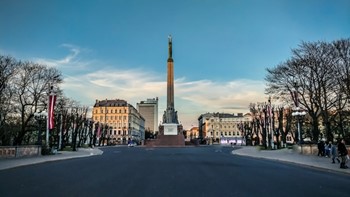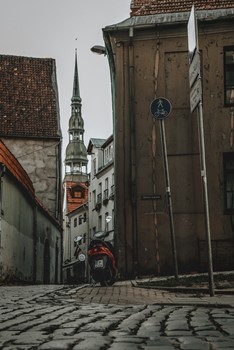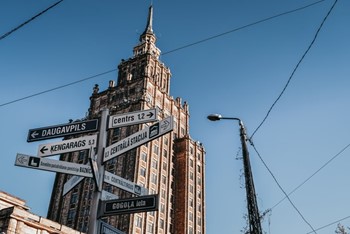Following the footsteps of the Soviet Era in Riga
Latvia has only been independent from the USSR since a little over 30 years. Hence, a lot of Latvians have still lived through this period. And it is no surprise that its influence is prevalent decades after the collapse of the Soviet political system to this day.
Follow the footsteps of the Soviet regime and occupation throughout Riga. From architecture to monuments and museums – history is still very much alive here.
Victory Park & Monument

This park inhabits one of Latvia’s most controversial monuments, the Soviet Victory Monument. The monument’s full name is 'Monument to the Liberators of Soviet Lavtia and Riga from the German Fascist Invaders'. It was built in 1985 and consists of a 79 meter tall obelisk and several statues made from bronze. They represent Mother Russia as well as a band of three soldiers with their weapons raised.
While there have been numerous attempts to have the monument removed, as many Latvians consider it to be not a symbol of victory but also the reoccupation of Latvia through the Soviets. Hence, some people refer to it as ‘Moscow’s finger.’

Originally constructed in in 1909, the park was part of the Russian Empire and later renamed in honor and to commemorate Latvia’s victory during the Latvian War of independence. The park is full of luscious green fields as well as routes for walking and skating. In winter, you can even find an artificial ski track here.
Museum of the Occupation of Latvia
This museum tells Latvia’s long history of occupation. From when it was first occupied by the Soviet Union in 1940 to 1941, by Nazi Germany from 1941 to 1944 and then again by the USSR until 1991.
The museum’s goal is it to remember and commemorate those unjustly convicted and murdered and remind the world of the crimes of the occupiers. The collection consists of almost 60,000 items as well as an audiovisual archive with more than 2,300 video testimonials of refugees, deportees and others affected.
The museum is located in a building that was built by the Soviets in 1971, originally constructed to celebrate what would’ve been Lenin’s 100th birthday. Until 1991, it was used as a museum in honor of the Red Latvian Riflemen. They were a Latvian regiment that was instrumental in establishing Soviet rule in Latvia in 1919.
Soviet era architecture

Even today, the USSR’s influence on Latvia’s architecture is prevalent throughout Riga. A lot of buildings stemfrom the late Soviet occupation, when the regime had banned all significant architectural décor for ordinary buildings.
The most prominent example of early Soviet architecture is the Academy of Science of Riga, also called Joseph Stalin’s birthday cake. It was constructed in the Soviet modernist style in the 1960s. There is also an observation platform at the top of the 65 meter high building.
You’ll find many more of these kind of buildings as well as whole city districts designed in this style all over Latvia. Today, they have a rather bad image though – ranging from low building quality and inefficient insulation.
KGB museum
Yet another building that signifies the influence of the communist party in Eastern Europe. The building of the KGB museums, also known as the ‘corner hourse’, tells a thousand stories over life under the USSR. This used to be the headquarter of the Soviet KGB in Latvia and where it interrogated and incarcerated Latvian citizens.
To this day, you can see the cells and how tough the conditions for the prisoners used to be here. Today, you can take a guided tour through the dreaded cellars, where thousands of Latvians were imprisoned, tortured and killed.
